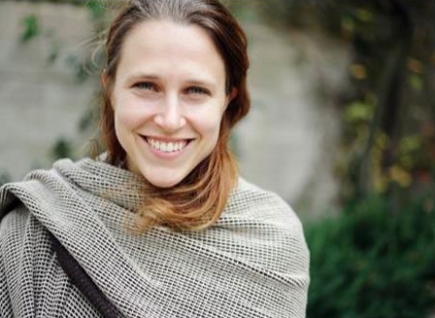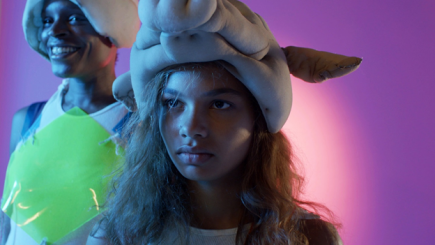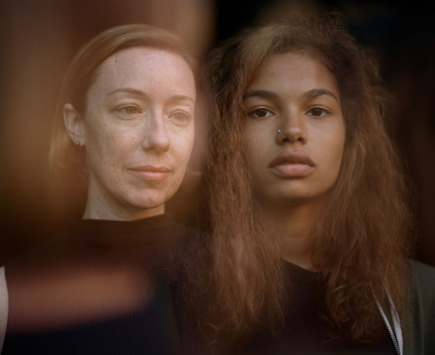Too often in films depictions of mental health are reduced to unrealistic caricatures based off stigma: the paranoiac scrawling symbols on the walls, the person whose split personalities just can’t get along or the histrionic, frazzled anxiety sufferer.
There is not a whiff of these outdated tropes within leagues of Josephine Decker’s Madeline’s Madeline: a powerful and uniquely illustrative portrait of a 16-year-old living with mental health concerns that’s finally arrived in UK theatres and showing at HOME.
This is Decker’s third feature after 2013’s Butter on the Latch and 2014’s Thou Wast Mild and Lovely. These film festival darlings established Decker as a unique eye who makes challenging works and Madeline’s Madeline certainly carries Decker’s experimental stamp.

From the outset there is a persistent sense of unease that makes you question what exactly you’re watching.
The camera is uncomfortably close to the characters and the use of shaky cam, copious blur and vivid colouring gives the entire piece a queasy feeling. Whilst the film is decidedly not a horror film, the cinematography apes some of the genre’s best modern examples.
During my years working in mental health services, I was consistently talking to clients about their experiences with psychosis.
This film perfectly evokes their reports of how the world seemed to them. Even though Madeline’s specific diagnoses are never named, to have ‘normal’ people experience that for the film’s 90 minute runtime was absolutely Decker’s intention.
“I wanted audiences to experience the ecstasy of [Madeline’s] imagination but also the darkness of it. The immersive concepts came from wanting to reflect the inside of her brain.”
In the year that Decker, the actors and the production team were developing the movie, Decker consulted with therapists, neurologists and people with lived experience of mental health problems to understand how best to represent them.
However, the most pertinent conversations Decker had were with a personal friend who was hospitalised in that year.
“A lot of what my friend kept saying was: ‘My life feels like a movie. It feels like colours are extraordinary. There’s a super-vivid lens on the world.’ For them it felt like reality wasn’t reality.”

These sentiments informed the narrative flow of the film. Rather than being the constant explanation for various plot beats, Madeline’s mental health concerns feel incidental.
As the title suggests, the film is simply about Madeline as Madeline: a complete human who’s about more than her issues, played brilliantly by Helena Howard in her first film.
“We didn’t want to depict mental illness we wanted to depict this character. We wanted to figure out Madeline in the context that was around her.
“The pressures from her family, school, being a teenager and wanting to fit in. There’s so much else going on in her life.
“When Madeline goes and has this ecstatic, fun roller-skating session with this boy, she then still comes home to the oppression of the bad guy in her mind.”
These shifts are not only captured by the deft use of various cinematic techniques but also through the expert sound design of Martín Hernández (The Revenant, Birdman).
Creative media hasn’t used sound so effectively to depict the lived experience of people with mental health concerns since the 2017 game Hellblade: Senua’s Sacrifice.
Speaking about Hernández’ sound design, Decker said: “It brought a new clarity to the film. We’re very much in Madeline’s mind right now or we’re experiencing something much more in reality.”
Within Madeline’s reality is the character of Evangeline: the director of an immersive theatre piece in which Madeline’s involved and the main narrative thread throughout the film.
Played by Molly Parker (Deadwood, House of Cards) she starts out as a confidant and potentially more apt matriarch than Madeline’s own mother, but her intentions quickly become more selfish.

As the film progresses, Evangeline begins to use Madeline’s troubles and experiences for creative gain. I wondered if Decker saw parallels between her role as a director making a film about mental health and the character of Evangeline.
Decker followed a similar process to creating this film as Evangeline does in trying to put together her theatre piece.
Both intend to form devised, collaborative works but whilst Decker had to take control due to time and financial pressures, Evangeline just wants to tell the story she wants under the pretence of collaboration.
“Evangeline is a strong critique of myself in that [collaborative] process and feeling I could only stay oblivious for so long.
“She’s the version of me if I had not seen things so clearly and tried to shy away from authority in a way that would not have been useful to the group to manifest what we wanted to create.”
Breathless. #madelinesmadeline nominated for BEST PICTURE for @ifpfilm Gotham Awards! Am humbled to be in that category with filmmakers whose work has inspired and change me: @BarryJenkins Chloe Zhao Yorgos Lanthimos and Paul Schrader! + HELENA HOWARD!!!!! https://t.co/wQSXNuy94a
— Josephine Decker (@JosephineJambox) October 18, 2018
One of the film’s most enjoyable traits is that it at no point explicitly tells you what to think. Decker’s writing, with Gail Segal, and her naturalistic direction ensures that opinions on characters are fluid, much like our opinions of people shift in real life.
This is true of the way the film builds to its dramatic apex and its ending which I read as bittersweet but others may not.
“It was important to me to keep it open. If you talk to five people after the film they have different experiences of the ending. I like to make movies where you can pull from it what you will. Some think it’s very happy but others think it’s very dark.”
It’s well worth taking an evening during this Mental Health Awareness Week to experience this piece for yourself.



